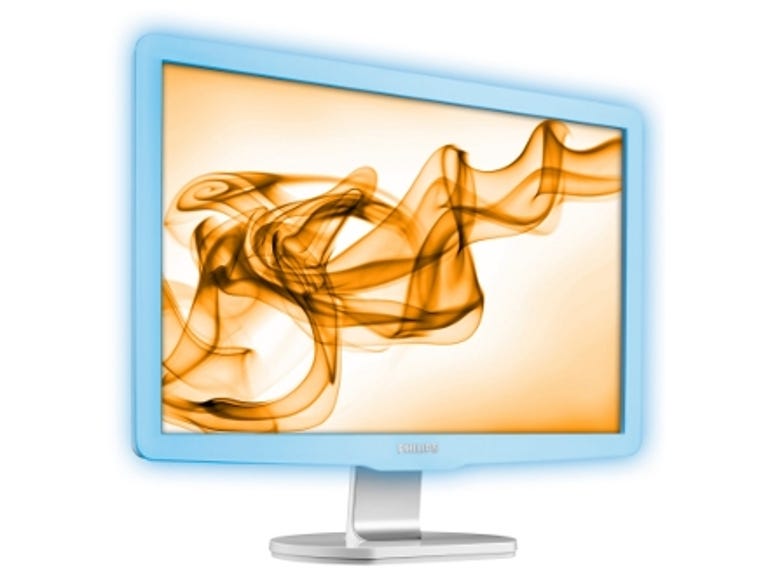 Why You Can Trust CNET
Why You Can Trust CNET Philips Brilliance 220X1SW review: Philips Brilliance 220X1SW
The attractive Brilliance 220X1SW is fairly expensive for a 22-inch monitor, but it offers very accurate colour reproduction and an illuminated bezel that's claimed to reduce eye strain and make for a more relaxing user experience. It certainly achieves the latter, and it's well-built to boot
Billed as a monitor that reduces eye strain, the 22-inch Philips Brilliance 220X1SW is designed for people who spend many hours a day stuck in front of their PC. Philips claims its illuminated bezel, which glows with a soft, calming blue light, will benefit your health at the same time as looking good. The 220X1SW, which has a 1,680x1,050-pixel resolution, is available for around £190.
The Good
The Bad
The Bottom Line
See the light
Philips refers to this lighting system as 'Lightframe'. It's not to be confused with the company's previous 'LightFrame' technology, available on earlier displays. The old LightFrame and the new Lightframe are two completely different things. We'd explain the former, but then you'd only end up as confused as we were when we first heard about this new display.
Designed to reduce eye strain and generally make you feel good, the 220X1SW's whole bezel lights up blue, creating an effect as though your desktop were magically floating in a mid-summer sky. Philips, being a rather massive fish in the lighting pond, is especially in love with ambient lighting effects, as can be seen from its Ambilight TVs and amBX PC gaming speakers. Lightframe achieves a similar effect and can be manually configured to glow brightly, dimly or not at all, but it has none of the built-in intelligence that allows the more sophisticated technologies to react to sound or light input.
We found that Lightframe did indeed create a rather relaxing working environment. The lowest setting seemed to work best, with brighter settings proving somewhat distracting. We would also have liked more fine control over the brightness, rather than the three discrete steps provided.
Accurate colours
We might like the Lightframe technology, but is the display itself any good? Thankfully, the answer is 'yes'. With past displays, Philips has put a great deal of hard work into maximising image quality, and the 220X1SW continues this trend.
Rather than trying to stretch, boost and manage original content with visually appealing tricks, the 220X1SW aims to faithfully reproduce that content by displaying very accurate colours, thanks to precise monitor adjustment and fine-tuning at the factory.
Philips' effort has clearly paid off. We calibrate all review monitors as part of the testing process and found that, with the 220X1SW, the calibration process made very little difference to what the monitor had already been displaying. This means that, if you're into photo- or video-editing but definitely not into hard-core monitor calibration, you can rest assured that this display will give you pretty good, accurate colours straight out of the box.
If you are a fan of boosting and mangling, however, Philips also offers a package of features dubbed 'SmartImage'. This is an automatic image-processing technology that analyses picture content and adjusts contrast, colour saturation and sharpness for optimum performance. It's rather like a clever version of brightness presets.
Although our preferred SmartImage setting would be 'off', you can also select from 'office work', 'image viewing', 'entertainment' and 'economy'. Each of these boosts, sharpens or dims the image in a number of pre-defined ways. The office-work mode reduces brightness for comfortable long-term use, while the image-viewing and entertainment modes boost colour and sharpness for a more immediately exciting, although less accurate, result.
Russian roulette
Unfortunately, the buttons for controlling these features have been somewhat inconveniently tucked away on the right-hand side of the display, behind the lip of the bezel. They're also really small and have almost illegibly small silver-on-white legends printed on them. On those admittedly rare occasions when you want to fiddle with the settings, you're left fumbling around in the dark, nervously playing Russian roulette with the off switch.
By contrast, some monitors actually reward you for venturing towards the controls: LG's W2353V, for example, will light up in a flirtatious manner at the approach of your hand, guiding your fingertips to the right spot. This might seem like a minor point, but the very reason for the 220X1SW's existence is meant to be the reduction, not creation, of stress.
The 220X1SW's overall build quality is pleasingly high, though, and there's a built-in single-port USB hub, as well as both VGA and DVI inputs.
Conclusion
The Philips Brilliance 220X1SW is a good monitor, and its Lightframe technology makes it fairly relaxing to use. But it's pretty expensive. You could pick up a pretty good, 1080p, 24-inch monitor for this price, including a HDMI port and built-in speakers, neither of which are available on the 220X1SW.
Edited by Charles Kloet
